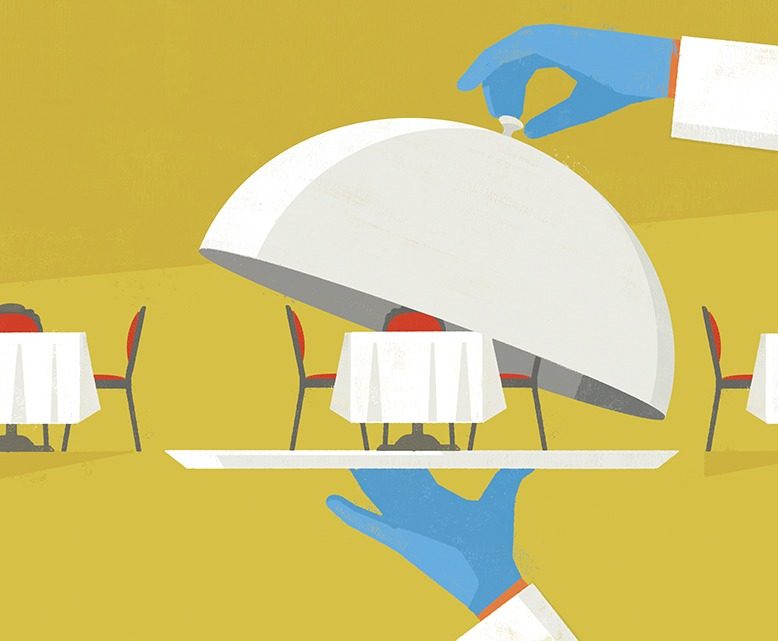
Back in January, Tim McLoone was running 12 restaurants, including McLoone’s Boathouse in West Orange, Iron Whale in Asbury Park and Robinson Ale House in Red Bank. Then came Covid-19. Only six are open now, surviving mostly on outdoor dining. Two have closed permanently.
“The demand for outdoor dining has been astounding,” McLoone says. “The dilemma is what happens in the fall, when it’s untenable to sit outside. A lot of people won’t make it.”
Weddings and parties once comprised nearly three-quarters of Tom Ingegneri’s business at the antique-laden Cranbury Inn. But weddings have all but disappeared in the pandemic. The Inn, one of the state’s oldest restaurants, closed in March for several months, with Ingegneri eventually reopening and so far holding on.
Over the summer, hospitality professionals played a fraught guessing game as to when Governor Phil Murphy would give a thumbs up to the return of indoor dining at whatever percent of normal capacity. On Monday, August 31, he threw the switch—indoor dining could return at 25 percent of full capacity as of Friday, September 4.
That decision, if it holds, moves an enormous needle. Hospitality—restaurants, bars, event venues—comprise one of the largest industries in the state, employing more than 260,000 people. Of course, a second wave of coronavirous infections, a spike traceable to restaurants or bars, and normalcy would again be on hold.
Even without the pandemic, there is little doubt that restaurants are in the midst of a huge disruption. The New Jersey Restaurant and Hospitality Association (NJHRA) has warned of a business fatality rate as high as 30 percent. For eateries that survive, will widely spaced tables, masked servers, sanitation squads and plexiglass partitions become permanent features of the restaurant experience? Will customers remain wary of walking into crowded venues?
“It’s clear there’ll be a lot of bankruptcies,” says Dr. Charles Feldman, a professor of food science at Montclair State University. “Restaurants need to get into a lean mode, where fewer people do more. The days of 200-seat restaurants may be over. I think you’ll see smaller operations with smaller staff, more counter service and takeout.”
The cost of dining out, he predicts, will go up to cover the rising cost of food and new cleaning protocols. Smaller staffs with greater responsibilities will want to be paid more, a notion that many operators may not be ready to embrace.
“People will want to go to restaurants,” the professor adds, “but it’s going to have to cost more.”
In the new era, Feldman argues, it is unsafe for so many workers to labor in the confined spaces of the kitchen, as they have for hundreds of years. To shrink the kitchen staff, Feldman believes restaurants may have to forgo making some foods from scratch, instead ordering from a “commissary operation where it’s mass produced and there’s less chance of cross-contamination.”
Also, the number of servers, who often earn far more in wages and tips than the people doing line prep and dishwashing in the kitchen, may shrink as restaurants offer counter service and employ new technology, such as point-of-sale (POS) computers that let customers view menus and place orders on their phones while sitting at a table. The systems also let operators offer gift cards and conduct e-mail marketing and reward programs.
In order to save hundreds of dollars a month in expenses, some restaurant owners are using POS technology to switch from third-party delivery by GrubHub and others—which take a hefty 30 percent of the order as a fee, paid by the restaurant—to hiring their own delivery drivers.
To make it all work, restaurants will likely have to raise their pay levels, particularly in the kitchen, known as the back of the house. In New Jersey restaurants, servers (front of the house) earn an average of $27,600 annually, including tips, according to a state labor department analysis in early 2020. But in top restaurants, they earn much more. Dishwashers and fast-food workers earn an average of $10.65 an hour, or only $22,100 a year.
It won’t be easy to rejigger the wage hierarchy. There are legal impediments to servers and bartenders sharing tips with dishwashers and prep cooks. The NJRHA opposes pooling tips. Some owners oppose the government even setting a minimum wage. Ingegneri of the Cranbury Inn complains that the rising minimum wage “has hurt” his bottom line.
But Jamie Knott, owner of the Saddle River Inn, acknowledges the wage gap is a problem. “I don’t like the vast disparity,” he says, “between the front of the house and the back of the house.”
Danny Meyer, who owns Union Square Café, Blue Smoke and Gramercy Tavern in Manhattan, announced five years ago that he would end tipping at his restaurants in favor of a consistent hourly wage. To cover the pay increase, he raised the cost of menu items by 15 to 20 percent.
Covid-19 has forced Meyer to reconsider. Eager to reopen for outdoor dining in New York, Meyer announced July 20 that he would drop the no-tipping policy so as not to deprive servers and bartenders of extra income during an economic crisis. Still, he is collaborating with the national One Fair Wage campaign to eliminate tipping.
Governor Phil Murphy, who took office in 2018, when the state’s minimum wage was $8.60 per hour, signed legislation last year that gradually raises New Jersey’s minimum wage to $15. As of January, it was $11. Even before the pandemic, restaurant owners said they had to offer higher pay to get well-qualified staff. A labor shortage has been exacerbated during the pandemic, some say, by the temporary $600-a-week federal supplement to unemployment benefits. The benefit helped many Americans stay afloat financially. But some restaurant workers were making more on unemployment than they would have working. That created a disincentive for some to return to their jobs. Others were reluctant to return to work for health reasons. Congress did not extend the supplemental benefit beyond July. President Trump issued an executive order approving a $300-a-week federal payment, but it is not expected to take effect until October.
“It’s a pretty sad state of affairs if your workforce can make more money on unemployment than going back to work,” Sara Cullinane, director of Make the Road New Jersey, said in June. “To get our economy going again, we need to make sure everybody’s able to pay their bills.”
Tim McMann, president of McLoone’s Restaurants, says that pay has been rising steadily, with dishwashers “knocking on the door of $15 an hour.” And, he added, “it’s not uncommon to find line cooks at $20 an hour or more.”
Whatever happens, Ingegneri of Cranbury Inn is certain it will cost more to eat out. “The price of meat, the price of fish have gone up,” Ingegneri says. “Everything’s going through the roof.”
It doesn’t stop with ingredients. Renovations to meet new health and safety rules cost money. Demetri Malki, who runs De Novo restaurants in Montclair and Edgewater, says he is operating at less than half capacity, even with outdoor dining. Yet his costs keep going up. He estimates that a third of the state’s restaurants will die by year-end.
Amidst Covid-19, health care benefits have been particularly dicey for restaurants, where many staff members are part-time, seasonal or transient. At smaller operations like the De Novo restaurants, there are no health benefits. “We wouldn’t be able to stay in business,” Malki says.
But larger operations are required by law to offer health care benefits to employees who work an average of 35 hours a week for three months running. McMann, of the McLoone group, says their costs turned out to be “manageable,” in part, because 90 percent of the 350 non-management employees opt to go without health benefits, while most in management sign up for it. In both cases, he said, those who get the benefits tend to stay with the company longer.
“Fine dining and anybody who doesn’t have outside dining is very challenged,” says Marilyn Schlossbach, who owns Pop’s Garage, Langosta Lounge and a catering company in Asbury Park, and chairs the NJRHA. “I think you’ll see a lot more closures in Monmouth and Ocean counties at the end of the season.”
“The bottom line in a good restaurant used to be 10 percent profit,” says David Burke, whose 14 restaurants include four in New Jersey (in Fort Lee, South Orange and two in Sea Bright). “It’s lower than that now. Think about all the risk that restaurateurs take, putting their hard work and money on the line, and then you’ve got jumpers [staff leaving for better pay] and bad weather, and then you’ve got a pandemic.”
Dominic Piperno, chef-owner of Hearthside in Collingswood, was booked through June and July when he served his last dinner March 14. He furloughed his managers and laid off his 22 employees. Piperno, who owns the building and lives with his family above the restaurant, admits that he is one of the few operators with the luxury of waiting. But overall, he is cautiously optimistic.
“One thing people don’t take into consideration,” he says, “is that this is a passion for us, it’s not just a job. This is what we live for. We’re 100 percent reopening. I just don’t know when.”
Charles V. Bagli has covered the intersection of politics, labor and real estate for 30 years for the New York Times and other publications. He is the author of the 2013 book Other People’s Money. He lives in Montclair.
